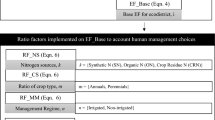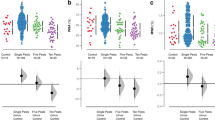Abstract
Academic, government, and industrial field researchers have generated a significant database of field studies of the volatility of soil applied fumigants. However, limited work exists in validating physical models against field volatility data sets and fully exploring the volatility parametric response surface. Field studies quantifying atmospheric flux for soil fumigants 1,3-dichloropropene and chloropicrin are validated against the United States Department of Agriculture (USDA Salinity Laboratory) soil physics model CHAIN_2D that was modified specifically for agronomic uses of soil fumigants. Comparison between model predictions and field observations for six unique field trials in five different states indicate that CHAIN_2D effectively captures the magnitude and duration of fumigant emission from soil observed experimentally with r 2 ∼ 0.14–0.96 (avg. 0.66) for peak emission, and r 2 ∼ 0.76–1.0 (avg. 0.91) for cumulative emissions (r equals the Pearson moment correlation coefficient). Correct prediction magnitudes suggest that CHAIN_2D is a useful tool for extrapolating flux predictions to diverse scenarios not addressed by field trials. Examples of mitigation strategies such as the use of agricultural films (tarps), increased soil injection depth, and management of soil water content, under near semi-infinite parameter combinations of soil, meteorological, and agronomic properties are discussed.












Similar content being viewed by others
References
Ajwa, H. (2007a). Fumigant emission reductions by using low permeability film and thiosulfate water seal. University of California, Davis. Abstracts of the 2007 Annual International Research Conference on Methyl Bromide Alternatives and Emissions Reductions. San Diego, CA, USA, October 29-November 1, 2007.
Ajwa, H. (2007b). Plastic film permeability to fumigants. University of California, Davis. Abstracts of the 2007 Annual International Research Conference on Methyl Bromide Alternatives and Emissions Reductions. San Diego, CA, USA, October 29-November 1, 2007.
Bakhsh, A., Hatfield, J. L., Kanwar, R. S., Ma, L., & Ahuja, L. R. (2004). Simulating nitrate drainage losses from a Walnut Creek watershed field. Journal of Environmental Quality, 33, 114–123.
Chen, C., Green, R. E., Thomas, D. M., & Knuteson, J. A. (1995). Modeling 1, 3-dichloropropene vapor phase advection in the soil profile. Environmental Science and Technology, 29, 1816–1821.
Cryer, S. A., van Wesenbeeck, I. J., & Knuteson, J. A. (2003). Predicting regional emissions and near-field air concentrations of soil fumigants using modest numerical algorithms: A case study using 1, 3-dichloropropene. Journal of Agricultural and Food Chemistry, 51, 3401–3409.
Cryer, S. A., Knuteson, J., Valcore, D. L., Olberding, E., & Schnelle, K. D. Estimating soil fumigant permeability of agricultural films using empty soil columns. Environmental Engineering Science, 26(1), 171-182.
Denmead, O. T., Simpson, J. R., & Freney, J. R. (1977). A direct field measurement of ammonia emission after injection of anhydrous ammonia. Soil Science Society of America Journal, 41, 1001–1004.
Gao, S., & Trout, T. J. (2007). Surface seals reduce 1, 3-dichloropropene and chloropicrin emissions in field tests. Journal of Environmental Quality, 36, 110–119.
Gao, F., Yates, S. R., Yates, M. V., Gan, J., & Ernst, F. F. (1997). Design, fabrication and application of a dynamic chamber for measuring gas emissions from soil. Environmental Science and Technology, 31, 148–153.
Knuteson, J. A., & Petty, D. G. (1995). Field Volatility Experiments for 1,3-Dichloropropene. In Abstracts of Technical papers, 210th National Meeting of the American Chemical Society, August 20-24, 1995. Chicago, IL; ACS: Washington, DC., USA
Majewski, M. S., Glotfelty, D. E., & Seiber, J. N. (1989). A comparison of the aerodynamic and the theoretical profile-shape methods for measuring pesticide evaporation from soil. Atmospheric Environment, 23, 929–938.
Papiernik, S., Yates, S. R., & Gan, J. (2001). An approach for estimating the permeability of agricultural films. Environmental Science and Technology, 35, 1240–1246.
Parmele, L. H., Lemon, E. R., & Taylor, A. W. (1972). Micrometeorological measurement of pesticide vapor flux from bare soil and corn under field conditions. Water, Air, and Soil Pollution, 1, 433–451.
Rolston, D. E. (1986). Gas flux. In A. Klute (Ed.), Methods of soil analysis. Part 1. Agron. Monogr. 9 (2nd ed., pp. 1103–1119). Madison, WI: ASA and SSSA.
Ross, L. J., Nicosia, S., McChesney, M. M., Hefner, K. L., Gonzales, D. A., & Seiber, J. N. (1990). Volatilization, off-site deposition, and dissipation of DCPA in the field. Journal of Environmental Quality, 19, 715–722.
Ruzo, L. O. (2006). Review: Physical, chemical, and environmental properties of selected chemical alternatives for the pre-plant use of methyl bromide as soil fumigant. Pest Management Science, 62, 99–113.
Šimùnek, J., & van Genuchten, R. (1994). The CHAIN_2D code for simulating the two-dimensional movement of water, heat, and multiple solutes in variable-saturated porous media. Research Report 136; U.S. Salinity Laboratory, USDA-ARS: Riverside, CA, USA
Šimùnek, J., van Genuchten, M. Th., & Šejna, M. (2008). Development and applications of the HYDRUS and STANMOD software packages, and related codes. Vadose Zone Journal, Special Issue “Vadose Zone Modeling”, 7(2), 587-600. doi:10.2136/VZJ2007.0077
USEPA (2000). EPI Suite v. 3.20. PCKOCWIN Module for QSAR estimation of Koc.
van Wesenbeeck, I. J., Knuteson, J. A., Barnekow, D. E., & Phillips, A. M. (2007). Measuring flux of soil fumigants using the aerodynamic and dynamic flux chamber methods published in 2007. Journal of Environmental Quality, 36, 613–620.
Wang, D., Yates, S. R., & Gan, J. (1997). Temperature effect on methyl bromide volatilization in soil fumigation. Journal of Environmental Quality, 26, 1072–1079.
Wang, D., Yates, S. R., & Jury, W. A. (1998). Temperature effect on methyl bromide volatilization: permeability of plastic cover films. Journal of Environmental Quality, 27, 821–827.
Wang, D., Yates, S. R., Gan, J., & Knuteson, J. A. (1999). Atmospheric volatilization of methyl bromide, 1, 3-dichloropropene, and propargyl bromide through two plastic films: transfer coefficient and temperature effect. Atmospheric Environment, 33, 401–407.
Wang, D., He, J. M., & Knuteson, J. A. (2007). DripFume: a visual basic program for simulating distribution and atmospheric volatilization of soil fumigants applied through drip irrigation. Computers and Electronics in Agriculture, 56(2), 111–119.
Wilhelm, S. (1996). Monitoring the potential worker exposure, field flux and off-site air concentration during chloropicrin field application: final report. Chloropicrin Manufacturers Taskforce Report No. HEH-160.
Wilhelm, S. N., Shepler, K., Lawrence, L. J., & Lee, H. (1996). Environmental fate of chloropicrin. In J. N. Seiber, et al. (Eds.), Fumigants: Environmental fate, exposure, and analysis.ACS Symp. Ser. 652 (pp. 79–93). Washington, DC: American Chemical Society.
Woodrow, J. E., & Seiber, J. N. (1991). Two chamber methods for the determination of pesticide flux from contaminated soil and water. Chemosphere, 23, 291–304.
Wu, L., Chen, W., Baker, J. M., & Lamb, J. A. (1999). Evaluation of the root zone water quality model using field measured data from a sandy soil. Agronomy Journal, 91, 177–182.
Yagi, K., Williams, J., Wang, N. Y., & Cicerone, R. J. (1993). Agricultural soil fumigation as a source of atmospheric methyl bromide. National Academy of Sciences, 90, 8420–8423.
Yates, S. R., Wang, D., Ernst, F. F., & Gan, J. (1997). Methyl bromide emissions from agricultural fields: bare soil, deep injection. Environmental Science and Technology, 31, 1136–1143.
Yates, S. R., Wang, D., Papiernik, S. K., & Gan, J. (2002). Predicting pesticide volatilization from soils. Envirometrics, 13, 569–578.
Yates, S. R., Knuteson, J., Ernst, F. F., Zheng, W., & Wang, Q. (2008). Effect of sequential surface irrigations on field-scale emissions of 1, 3-dichloropropene. Environmental Science and Technology, 42(23), 8753–8758.
Acknowledgements
The authors thank DAS colleague Bruce Houtman who was instrumental in allocating management support and having the vision for mechanistic modeling’s role as a supplement to experiment. Members of the chloropicrin manufacturing taskforce require thanks (most notably Steve Wilhelm and Sara Beth Watson) for technical and travel support to various conferences and public meetings, and to numerous USEPA scientists, led by Jeff Dawson, who provided feedback/review for the interface and code functionality and critical use of the numerical tool in a regulatory setting.
Author information
Authors and Affiliations
Corresponding author
Rights and permissions
About this article
Cite this article
Cryer, S.A., van Wesenbeeck, I.J. Estimating Field Volatility of Soil Fumigants Using CHAIN_2D: Mitigation Methods and Comparison Against Chloropicrin and 1,3-Dichloropropene Field Observations. Environ Model Assess 15, 309–318 (2010). https://doi.org/10.1007/s10666-009-9208-4
Received:
Accepted:
Published:
Issue Date:
DOI: https://doi.org/10.1007/s10666-009-9208-4




